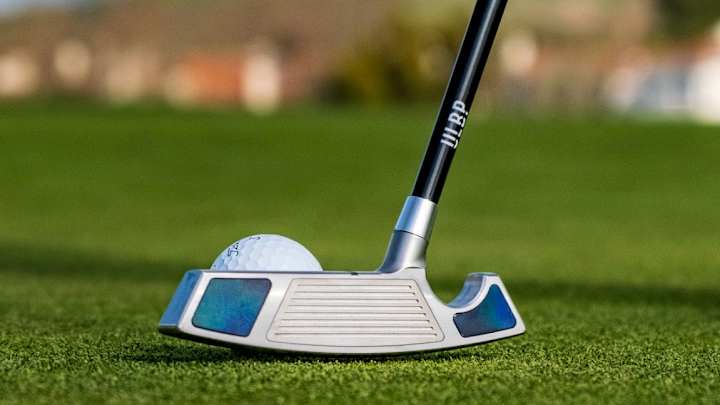A labor of love

Is there a more personal club in the bag than your putter?
Most of us think nothing of sampling the latest driver on the market or can be easily persuaded to test a new set of irons or sand wedge. But a new putter — the extension of our golfing heart and soul — now that’s asking a lot.
Why the attachment, I have often wondered? We can miss countless 5-footers or three-putt several times a round but blame our nerves, aging eyesight or bad alignment for poor performances on the greens. It’s never our beloved putter, correct?
I myself still carry around a Slotline I won at a caddy banquet in the early 1970s. It’s not as if I’ve made a ton of putts with it over the past four decades. Quite the opposite, in fact, but I guard that sucker with my life.
It’s certainly more sentimental than success driven, and I hadn’t thought much about my putting woes until a recent interview with Steve Sacks and Rich Parente, two of the more influential figures in the golf industry who have partnered to create what they call “the most scientifically perfect putter.”

Each has a golfing resume as long as my driver shaft — a combined 100 years of club-marking experience — but I first scoffed at the notion that these two impressive gentlemen of the game had created something so special, so unique that I just had to try a Sacks Parente Golf Co. putter.
I listened to Sacks and Parente talk at length about such things as weight distribution, carbon fibers and even the company’s patent called the Ultra Low Balance Point. The ULBP is defined as a balancing point below 5 inches from the sole of the putter, promoting a natural pendulum motion, with minimal effort, that automatically squares the putter head at impact and improves your speed control.
“Believe me you will feel the difference,” Parente said prior to the firm shipping me one of its Series 39 Blade putters. “A lot of people think the head feels heavy. It’s not; the heads are standard true weight, which is about 355 grams. What you are actually feeling is the putter head. Putters up until now had a balance point of 7, 8 or 9 inches up from the sole, so what you were feeling there was the shaft and not the head. So, for the first time ever, you will be able to feel the head of the golf club, and feeling the head enables you to control the head.”
When the package arrived, it was so light it was hard to believe a putter was inside. And I must admit that I am normally more impressed by golf course architecture than golf equipment, but this new putter had me shaking my head over its precise design and unique feel.
But the true test awaited — a golf course green.
My first round with my new blade saw me make four long putts, a rarity for me. The feel was outstanding, but I chalked some of that putting success to beginner’s luck with a new club. Then a second and third round also proved as productive with the new flat stick.
“We’ve taken all the weight out of the grip and the shaft … so what you get is a putter head that just wants to release,” Sacks said. “If you take it back and start bringing it forward that putter just wants to go forward, and wants to square itself up and be more accurate. It doesn’t matter what your stroke is it’s just the way physics work. We didn’t invent this. It’s really physics that we applied to a putter.”
Every Sacks Parente putter is hand crafted and 100 percent milled from the finest stainless steels and aluminums, using as much as 126 grams of stabilizing tungsten, resulting in a cost between $600 and $5,000 each.
“Everybody else is in a Cadillac world and we’re kind of driving a Ferrari,” said Sacks, the co-founder of Godwin Golf whose club expertise dates to 1974. “Getting technology into a putter is long in coming because I believe if you don’t make putts nothing good happens on the golf course. You can’t win any bragging rights and you can’t score. I think putters are the most important club and I’m OK with spending a lot of money on the technology.
“We try to build stuff that no one else wants to spend the money to build, which means we can use a lot of tungsten and move it around. If you look at our designs we’ve introduced so far there really is nothing out there that is copying anybody. We’re just trying to make something that more or less looks traditional that is super high performance. No one out there is doing super high performance.”
Parente, who recently turned 80, the first president of Callaway Golf, and Sacks first met while working for opposing golf companies and in 2011 they conceptualized the specific redistribution of weight throughout the putter, beginning a journey of development, perfecting technologies, materials selection, along with relentless testing and evaluation.
“We’re always tinkering,” said the 65-year-old Sacks. “Rich and I spend 2-3 days a week trying to figure out stuff and throwing ideas at each other. We ask ‘what if’ a lot. Some of the ideas are pretty stupid and some of them are pretty smart.”

There is little argument that the design of the firm’s putters is intense. For example, Sacks says there is two years of technology invested in the mallet putter series.
“It took probably 200-300 hours sitting at the computer and carving something in wood,” Sacks said. “Rich sees this stuff in his mind but I have to test and feel it. I do a lot of stuff with wood or foam or whatever.”
Parente and Sacks spent the better part of 2019, with the company still in its infancy at less than two years old, trying to introduce its revolutionary putter design to PGA Tour player reps … and anyone else who will listen.
“We’re doing extremely well in Japan because price point in Japan is not a problem,” Parente said. “In Japan, they want the technology, they want the absolute best. So in order to have the best you have to spend money. Our investors wanted the absolute best and cost was not a consideration. So, if you take a couple of designers like Steve and myself and turn us loose
where money is no option we just went off and made the most technologically sound golf clubs we could come up with.”
Sacks Parente Golf Co. has two reps beating the bushes of the professional golf tours, trying to get some of the best players in the world to try its new product. Ken Duke on the PGA Tour Champions currently uses a Sacks Parente putter.
“If you want to survive in the industry you have to be on Tour,” Sacks said. “In addition to Ken Duke we have had 20 or so pros that have put our putters into play at one time or another. And we’re going to grow that. The public has to see that before they want to buy it.”
“We are still a start up and a small operation, and you can’t get to everybody at once. We try to get them to understand our technology and to believe in it as much as we do … and some do and some don’t … and some will in the future.”
But in the end, this is a labor or love for Sacks and Parente.
“If I didn’t do this I would probably shrivel up and die,” Sacks said, “Most of the putters we sell are between $600-$1,200, so it is definitely serious money. But all we’re doing is trying to make the game better. Let’s have fun with that idea. If it’s not fun then why are we doing it? It’s fun for us to make these putters; fun for you to play and fun to make more putts.”
“All of these technologies really do work, and I love to hear what people have discovered from using our putters,” added Parente from his Imperial Beach home in Southern California. “But in the end it has to hav the look and it has to perform.”
